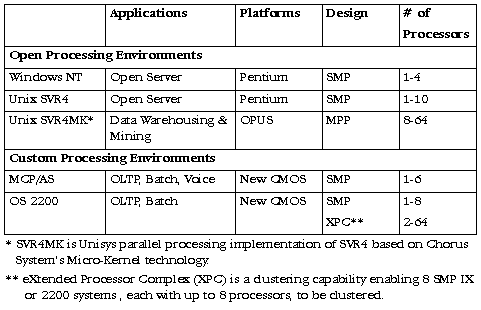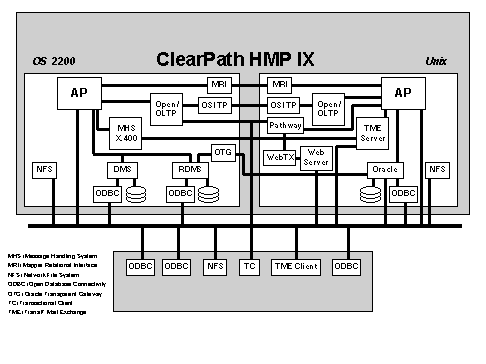PO Box 500
Blue Bell, PA 19424-0001
1-800-448-1424
Unisys ClearPath Heterogeneous Multi-Processing (HMP) servers combine new CMOS versions of MCP/AS and OS 2200 enterprise servers with Intel based Unix/NT Symmetric Multi-Processing (SMP) servers. With HMP, customers can capitalize on the combined benefits of a robust, resilient and scalable mainframe operating environment and an open Windows NT or Unix environment. Pre-integration by Unisys substantially enhances using the combination to implement sophisticated client/server applications. In future releases, Unisys promises to integrate its OPUS Massively Parallel Processing (MPP) system into this powerful, new hardware design.
While Unisys is committed to transforming itself into a services-based information management company the sale of large-scale computer systems continues to be the company's major source of revenues -- 40% of Unisys $6.2 billion in 1995. Thus, the unveiling of Unisys ClearPath HMP series is an important event for Unisys and its customers. This Aberdeen Profile will describe Unisys new ClearPath servers -- initial versions of which are being announced in April, 1996 -- as well as various benefits associated with the HMP architecture that will be enhanced and rolled out over time.
ClearPath HMP is the descriptor Unisys devised for a new series of enterprise servers specifically engineered to provide its worldwide base of more than 8,500 mid- to large-range A Series and 1100/2200 customers with a "clear path" to the multi-tier applications of the future. Many of these customers have been waiting for Unisys vision of how they should prepare to implement open, client-server applications, and this announcement provides an effective architecture for modernization and re-engineering applications.
In addition to giving its mainframe customers the ability to implement client/server at a sensible pace, it also gives them a "path" to new, cost effective CMOS upgrades to their A and 2200 systems. CMOS delivers a smaller footprint that saves on floor space and power consumption without sacrificing performance. The new enterprise server models preserve customers' investments in mission critical applications and provide the means to build new applications on an integrated HMP system as a natural, evolutionary process. ClearPath HMP permits customers to link and manage the model in a single cabinet.
With ClearPath, Unisys becomes the first supplier of large-scale enterprise servers to replace its entire line -- even the higher-end -- of ECL systems with CMOS alternatives. Unisys has designed a 0.5 micron CMOS technology which IBM fabricates to implement their new high-end processors, which are expected to deliver about 40-60 MIPS of processing performance.
ClearPath HMP development has been underway for about two years, and Unisys has built servers with the following major components:
Unisys approach in closely integrating an Intel-based processing environment with MCP and OS 2200 enterprise server environments for cooperative production processing is unique. IBM's PC Server 500 S/390 is similar to ClearPath HMP only in that integrates an IBM developed S/390 microprocessor (P/390) in a PS/2 PC enabling ESA/390, S/370 and S/370-XA applications to be run in conjunction with OS/2. However, IBM's PC Server 500 S/390 is not designed for production as is ClearPath HMP. Instead, it is intended primarily for use as a departmental workstation for application development.
In Unisys HMP implementation, the Intel and custom processing environments are coupled in a variety of ways to effect communications between the two environments. In time, Unisys plans to replace the cable interface with a high performance shared memory interface. This will be especially advantageous to an integrated OPUS system (Unisys Massively Parallel Processing system), allowing it to capitalize on the fast flow of timely data from an OS 2200 or MCP/AS in its data warehousing/data mining operations.
Why implement client/server applications on a Unisys ClearPath HMP System versus a distributed system alternative comprising low cost servers from Sun, Digital, Hewlett Packard, et. al? In addition to offering the open processing capabilities of a Unix/NT server, ClearPath HMP provides the high-volume transaction processing, fault tolerance, and massive scalability of an enterprise server. Comparable capabilities aren't available with the distributed approach.
For A and 2200 Series enterprise users, ClearPath HMP servers offer a fully compatible environment for executing existing applications. Hence, the re-engineering of applications to work in a client/server environment can proceed at the users' own pace, on the same system. Conversion to a distributed alternative while continuing to operate MCP or OS 2200 enterprise server installation will generally be much more costly and time consuming, with no additional benefits accrued. Surveys indicate that Unisys approach with ClearPath HMP might prove very timely. For example, in a large-scale survey conducted in 1995 by Softlab, 60% of the users surveyed viewed their existing enterprise server applications as a "business critical" asset. 38% planned to employ front-ends to integrate the applications with client/server architectures. Another 31% planned to integrate remote departmental open systems with centralized enterprise servers.


Source: Aberdeen Group, April 1996

To facilitate client/server implementations, Unisys offers a GUI-based ClearPath HMP Application Development Environment (ADE) facility, initially for the IX models. NX models will use Microsoft APIs using off-the-shelf client builder tools. Operations are facilitated by the availability of a Single Point of Operation (SPO) capability and systems management software.
The ClearPath HMP Series offers a wide selection of software products, proprietary and open, and middleware that bridges both so they operate together in a seamless fashion. Most important, all of the software products are guaranteed to operate together in any combination. This is a welcome reprieve from the problems that are typically encountered in getting heterogeneous systems to operate with each other in a distributed client/server network.
The breadth of software that is available gives outstanding versatility to Clear-Path HMP servers. Options for users that Unisys will ship in 1996 include:


Source: Unisys, April 1996

A European bank using an A Series plans to install an NX system using the NT environment to perform security screening of transactions before passing them to the MCP/AS environment for processing. An OS 2200 user is considering off-loading some of the OS 2200 processing onto a Unix environment in an IX system. At announcement, Unisys is expected to reveal many first-day orders.
A ClearPath HMP Series system can be configured to act as a fully featured, high performance Hypertext Transfer Protocol (HTTP) server on the World Wide Web (WWW). Alternatively, it can be configured to operate as an Intranet or combined Internet/Intranet server. A powerful feature of the Web server implementation is its ability to access the legacy data and generate HTML pages dynamically -- allowing for it to handle transactions.
The high-volume transaction processing, fault tolerance, and scalability of ClearPath HMP enterprise servers will rise in demand as inexpensive PC servers are found to lack the needed scalability, and more powerful Internet/Intranet servers are required to assume the bulk of the processing load.


Source: Unisys Corporation, April 1996

Current A Series and OS 2200 customers who wish to take advantage of this new technology are required to upgrade their current systems to the new CMOS-based ClearPath HMP Servers. Customers are given a wide range of possible combinations of hardware and software. Unisys has taken much of the potential pain out of the integration possibilities by packaging a set of tools, templates and on-line documentation -- PathMate -- to help with the system design, installation, configuration and administration.
The ClearPath HMP series presents flexible, leading edge alternatives to Unisys A and OS 2200 data center customers. They can modernize existing applications by implementing open NT and Unix interfaces, continuing to realize the benefits of an enterprise server processing environment. Additionally, they can transition to client/server by continuing to run their existing applications as is, build new applications on any ClearPath HMP component and then link them together through the Unisys-provided middleware.
Later in 1996, ClearPath HMP will accommodate close integration of a robust MCP/AS or OS 2200 transaction environment with an OPUS data warehousing/data mining environment for decision support. The combination is an attractive alternative and should bolster OPUS business in Unisys A and OS 2200 series base.
The ability to configure ClearPath HMP as a robust, highly scaleable node in the Internet or in an Intranet and the ability to configure the NX models with NAP to support large-scale voice messaging and E-mail applications should help Unisys sell the new series outside its customer base. NAP is an A Series voice capability that supports the enhanced voice services applications at telcos worldwide. PacTel and Nynex are major users in the U.S. Many more significant accounts exist over-seas. NAP business, which has grown substantially over the past few years, is derived primarily from new name accounts. Availability of a Windows/NT environment will enable Unisys to expand into electronic mail markets with NAP.
Aberdeen Group is convinced ClearPath HMP will be well-received by Unisys A and OS 2200 customers, both end-users and third parties.

Aberdeen Group [ http://www.aberdeen.com/ ]
One Boston Place
Boston, Massachusetts
02108
Telephone: 617-723-7890
FAX: 617-723-7897

The trademarks and registered trademarks of the corporations mentioned in this publication are the property of their respective holders. Unless otherwise noted, the entire contents of this publication are copyrighted by Aberdeen Group, Inc. and may not be reproduced, stored in a retrieval system, or transmitted in any form or by any means without prour written consent of the publisher.
Copyright © 1996 Aberdeen Group, Inc., Boston, Massachussetts